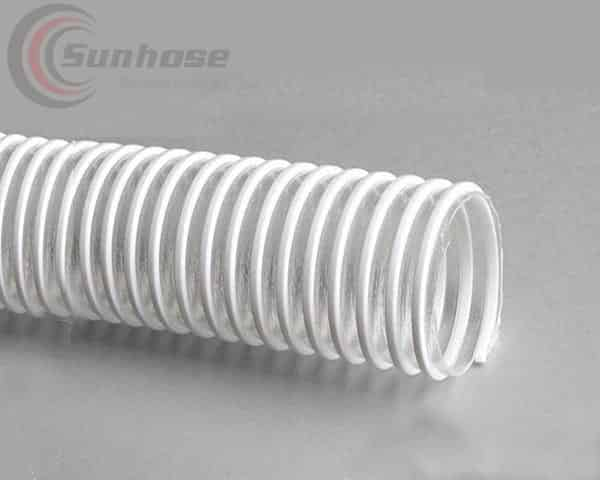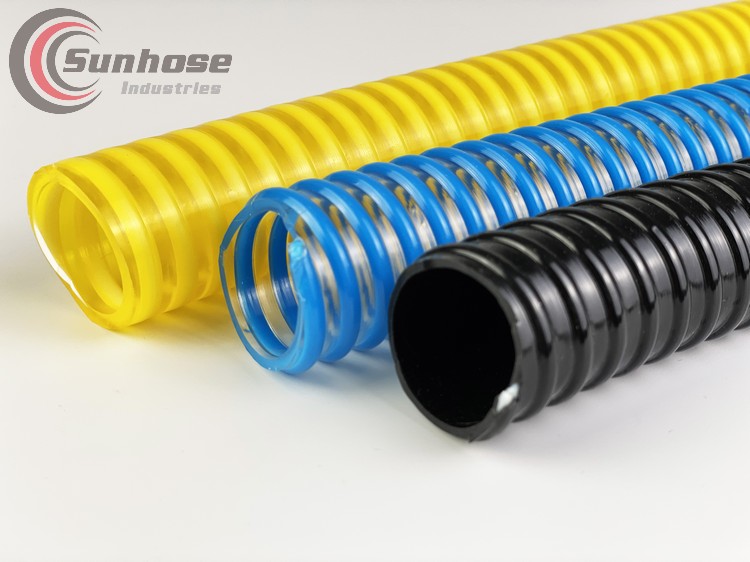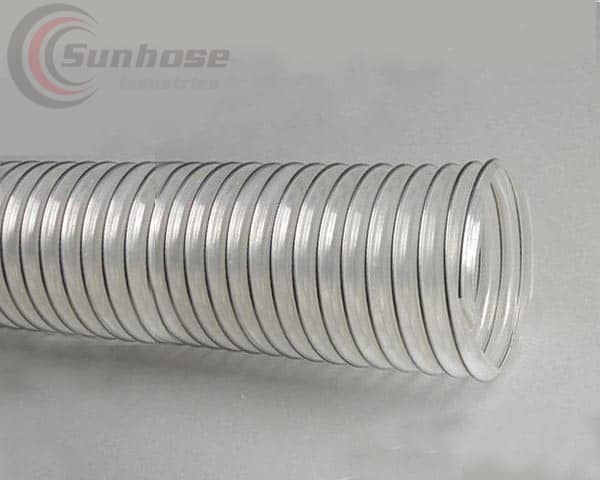The Difference Between PU Helix and PVC Suction Hose
When it comes to industrial hoses, two common options that often come up are PU helix and PVC suction hoses. These hoses are widely used in various applications, including agriculture, construction, mining, and more. While both PU helix and PVC suction hoses serve similar purposes, they have distinct differences in terms of material composition, performance, and durability. In this article, we will explore these differences and help you understand which hose is best suited for your specific needs.
- Overview of PU Helix and PVC Suction Hoses
- Material Composition
- Flexibility and Handling
- Chemical Resistance
- Temperature Resistance
- Abrasion Resistance
- Pressure Rating
- Application Areas
- Maintenance and Care
- Cost Comparison
- Environmental Impact
- Choosing the Right Hose for Your Needs
- Conclusion
- FAQ
1. Overview of PU Helix and PVC Suction Hoses
PU helix and PVC suction hoses are both designed for fluid transfer applications where the suction and discharge of liquids, powders, and granules are required. These hoses are commonly used in industries such as agriculture, construction, mining, and waste management. While they may appear similar at first glance, their differences become apparent upon closer examination.

White TPU suction hose
2. Material Composition
PU helix hoses are made from polyurethane, a synthetic polymer known for its exceptional strength and durability. Polyurethane offers high abrasion resistance, making it ideal for heavy-duty applications. On the other hand, PVC suction hoses are made from polyvinyl chloride, a versatile thermoplastic known for its flexibility and affordability. PVC hoses are generally softer and more lightweight compared to PU helix hoses.

suction hose PVC
3. Flexibility and Handling
PU helix hoses are highly flexible, allowing for easy maneuverability in tight spaces. Their flexibility also makes them less prone to kinking, ensuring an uninterrupted flow of materials. PVC suction hoses are also flexible but have a slightly lower flexibility compared to PU helix hoses. However, PVC hoses are easier to handle and coil due to their lighter weight and softer construction.

TPU Suction Hose
4. Chemical Resistance
PU helix hoses exhibit excellent resistance to a wide range of chemicals, including oils, fuels, acids, and alkaline substances. They are suitable for applications where chemical resistance is crucial. PVC suction hoses, on the other hand, have moderate chemical resistance and may not be suitable for handling aggressive chemicals or solvents. It’s important to consider the specific chemical compatibility requirements of your application when choosing between the two.
5. Temperature Resistance
PU helix hoses have a broader temperature resistance range compared to PVC suction hoses. They can withstand higher temperatures, ranging from -40°C to 90°C (-40°F to 194°F). PVC suction hoses have a lower temperature resistance, typically ranging from -10°C to 60°C (14°F to 140°F). If your application involves extreme temperature conditions, PU helix hoses may be the better choice.
6. Abrasion Resistance
One of the key advantages of PU helix hoses is their exceptional abrasion resistance. They are designed to withstand heavy wear and tear, making them suitable for applications that involve rough surfaces or abrasive materials. PVC suction hoses have moderate abrasion resistance but may not be as durable as PU helix hoses in demanding environments.
7. Pressure Rating
PU helix hoses generally have a higher pressure rating compared to PVC suction hoses. They can handle higher-pressure applications, making them suitable for situations where a strong and reliable hose is required. PVC suction hoses have a lower pressure rating and are better suited for applications with lower pressure requirements.
8. Application Areas
PU helix hoses are commonly used in heavy-duty applications such as mining, construction, and agriculture. They are ideal for handling abrasive materials, slurries, and solid particles. PVC suction hoses are versatile and find applications in industries such as agriculture, irrigation, drainage, and general fluid transfer where chemical resistance is not a primary concern.
9. Maintenance and Care
Both PU helix and PVC suction hoses require regular maintenance and care to ensure optimal performance and longevity. Cleaning the hoses after each use, storing them properly, and inspecting them for any signs of damage or wear are essential steps in maintaining their integrity.
10. Cost Comparison
In terms of cost, PVC suction hoses are generally more affordable compared to PU helix hoses. PVC hoses offer a cost-effective solution for applications that don’t require high chemical resistance or extreme durability. PU helix hoses, although more expensive, provide superior performance and longevity, making them a worthwhile investment for applications that demand heavy-duty performance.
11. Environmental Impact
Both PU helix and PVC suction hoses have environmental considerations. PVC is known for its recyclability, making it a more environmentally friendly option. However, the manufacturing process of PVC involves the use of certain chemicals that can be harmful to the environment. PU helix hoses, while not as easily recyclable, have a longer lifespan and require fewer replacements, reducing waste in the long run.
12. Choosing the Right Hose for Your Needs
When choosing between PU helix and PVC suction hoses, it’s crucial to consider your specific application requirements. Evaluate factors such as chemical resistance, temperature range, pressure rating, abrasion resistance, and budget to make an informed decision. Consulting with a trusted hose supplier or industry expert can also provide valuable insights and guidance.
13.Conclusion
In conclusion, PU helix and PVC suction hoses are two distinct options with different material compositions and performance characteristics. PU helix hoses offer superior abrasion resistance, chemical resistance, and temperature resistance, making them suitable for heavy-duty applications. PVC suction hoses, on the other hand, provide flexibility, affordability, and moderate chemical resistance, making them versatile for various fluid transfer needs. By understanding the differences outlined in this article, you can choose the right hose that best suits your specific requirements.
14.FAQ
1. Are PU helix hoses suitable for use with food products?
PU helix hoses are not recommended for use with food products as they may leach certain chemicals that can contaminate the food.
2. Can PVC suction hoses handle suction and discharge applications?
Yes, PVC suction hoses are designed to handle both suction and discharge applications, making them versatile for fluid transfer needs.
3. Which hose is better for handling abrasive materials?
PU helix hoses are specifically designed for handling abrasive materials and offer superior abrasion resistance compared to PVC suction hoses.
4. Are PVC suction hoses resistant to UV radiation?
PVC suction hoses have moderate resistance to UV radiation but may degrade over time when exposed to prolonged sunlight.
5. Can PU helix hoses be repaired if damaged?
PU helix hoses can be repaired using appropriate repair kits and methods. However, it’s recommended to replace extensively damaged hoses for optimal performance and safety.

 Sunhose
Sunhose sunhose
sunhose